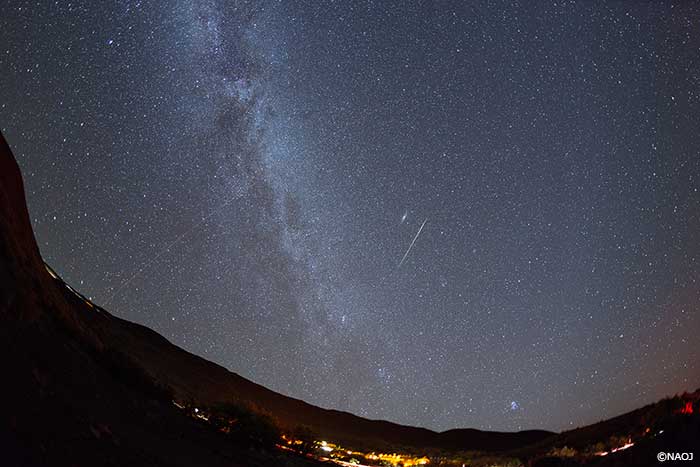The Night of the Perseids Meteor Shower on Mauna Kea
Night Scape Photograph・

| Date | 1:04 am August 12, 2013 (Hawai‘i Standard Time) |
|---|---|
| Camera | Nikon D600 |
| Lens | 15 mm F2.8 EX DG DIAGONAL FISHEYE |
| Exposure | f/2.8, 90 seconds, ISO3200 |
| Location | Onizuka Center for International Astronomy Visitor Information Station on Mauna Kea , Hawai‘i Island |
| Photographer | Shogo Nagayama |
| Copyright | National Astronomical Observatory of Japan |
Suddenly a Meteor Pierces the Night Sky. On the peak night of the Perseids meteor shower, the six-day-old waxing crescent moon had set earlier so that only starlight illuminated the night sky as countless meteors cut across it. The world’s large telescopes are gathered together on the summit of Mauna Kea on Hawai‘i Island. The superb belt of light, the Milky Way, stretches out in the night sky seen from the midpoint of the mountain. Likewise, the stars appear to be within arm’s reach. On the peak, metaphorically reaching out to that Universe, telescopes look into the silent night sky.
Star Clusters and Galaxies Ornamenting the Night Sky
One of the Perseids meteors cuts across the center of the image from the lower left to the upper right. A line traced down and to the left from the meteor’s track points back to the origin of the meteor shower, located within the Milky Way. The star cluster visible just above the origin point is the Double Cluster in the constellation Perseus. The elongated blob of light above the meteor track is the Andromeda Galaxy (M31) in the constellation Andromeda. The star cluster Subaru (Pleiades, the Seven Sisters) in the constellation Taurus peeks out from the eastern (right) horizon, foreshadowing the coming winter.
On the Summit of Mauna Kea
The left side of the image faces towards the summit of Mauna Kea. You can see light from the red laser projected by the United States’ W.M. Keck Observatory during observations. Even with the stable atmosphere of Mauna Kea well suited for astronomical observations, this observational technique is required to obtain higher resolution data.
The Perseid Meteor Shower
The peak of this high-number-count meteor shower occurs every year around August 12. The effect of the moonlight makes ease of observation different each year. In 2014, the Moon will be just past full phase, so it can’t be called ‘easy’ compared to last year, but it will still be possible to see more meteors than on a normal night.
Author: Tomoko Ono (NAOJ Public Relations Center)